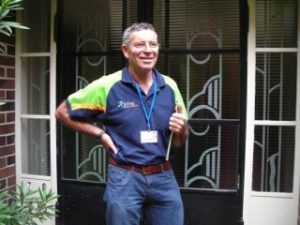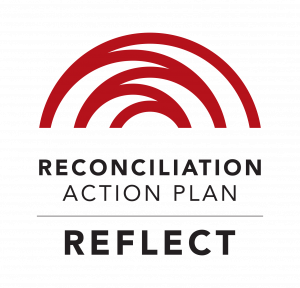
His first client was a young gentleman who needed a general-purpose tray fitted to his wheelchair so he could work a laptop, eat his dinner while watching TV and read a book. The client’s wheelchair was worth thousands of dollars but it had no off-the-shelf tray available from the suppliers and there were no fitments for a generic tray
Earlier this year I interviewed volunteer Peter Doyle who works with Solve Disability Services. I was impressed by Peter’s great sense of satisfaction volunteering for an organisation that puts his unique skills to good use. Through his volunteering work he is in turn helping so many people with special needs gain increased mobility.
“I was retired, had time on my hands and needed something worthwhile and fulfilling to do outside the house,” he told me.
What led Peter to volunteer?
How did Peter find the perfect match with the right volunteering organization? It happened one day when he was listening to ABC radio. Someone was being interviewed on air about the successful work achieved by Solve Disability Solutions. Solve works with a team of volunteers, mostly retired engineers and technicians, who design and make equipment to improve mobility for people with special needs.
Peter decided then and there that this was the volunteer work for him. An engineer by profession, he had had to take early retirement to care for his wife Barbara. Barbara’s terrible illness and resultant disability was to help him find his destiny in helping others.
“About six years ago my wife Barbara got ill with a kidney disease and we couldn’t have known the terrible consequences of the infection leading to septicemia and how swiftly it can disable or affect a person.”
Barbara had always been well, fit and athletic but as a result of her sudden illness and the rapid rate the infection carried, she had to have both legs amputated. But Peter’s battle really began when she was given the okay to leave hospital. He quickly discovered that there was basically very little immediate support for the functional needs to support her mobility at home.
“There was a lack of information. We couldn’t even find what was needed in the way of aids and equipment to support daily living. There were mobility problems and this led to the problem of finding a suitable wheelchair, a suitable shower chair, how to get handrails installed around the house – in doorways, the shower and toilet. There was the problem of accessing steps because our house is on a steep hill so it wasn’t really suitable for wheelchair access,” said Peter.
Peter’s dilemma to get Barbara home
Peter faced a real dilemma. As there was no wheelchair access to the house and the house wasn’t fitted with the above aids and equipment suitable to support Barbara, she was not allowed out of hospital because of health and safety considerations.
“I was devastated with whole situation. My wife was lying in hospital unable to come home even though she’d recovered. I felt very much alone, and that it was up to me to provide solutions to the situation,” he said.
He researched organisations that provide specialized equipment construction for aids and equipment but soon found these very unsatisfactory, as there were issues with time frames and high costs. That was when Peter knew he had to do something himself. Luckily he had a technical and engineering background and knowledge of the tools required to do the construction work.
“I decided to take action. I went to the hardware shop, purchased materials to build and construct wheelchair ramps, rails, steps and access. I set to work drawing a plan of the interior and exterior and requirements. I researched standards for aids and equipment on the Internet as there seemed to be no organization or person to ask.
Peter takes the initiative
Then he began building. Day and night he toiled away because time was of the essence.
“Barbara my wife wanted to leave the hospital and I wanted her to be home. She had been there three months and it was Easter holiday time and we wanted to have family time,” he said.
Busily he hammered and drilled the days away in his workshop and outside the house constructing and installing the necessary equipment to enable Barbara to leave hospital.
She came home and they proceeded to manage the situation, assessing her requirements and implementing extra building work as required.
The lead to his volunteering
“And that’s when I heard the interview about Solve Disability Solutions on ABC radio! After I’d done all the hard work by myself!” laughed Peter.
“But I felt that other people involved in this type of hardship would not be in the position to help by themselves. I‘ve always been community minded and decided I had to do something,” he said.
Peter contacted Solve Disability Solutions and attended an interview to assess his suitability for volunteer work and also to understand what Solve did, how it functioned as an organisation.
With Barbara happily at home again, Peter took up his new volunteer position. A team was formed within Solve with Peter as technical volunteer and a Solve project manager/occupational therapist.
“We met to discuss the needs of the my first client. I immediately felt a strong sense of purpose. I was about to really help a person to live a fuller life. He or she would be able to do more, move about easier,” he said.
Solving clients’ mobility needs
“Unfortunately, even if there is a generic tray, often it doesn’t suit or fit the needs of the client’s situation as each special needs’ person has different mobility priorities,” he said.
Another of his clients tended to shower in the middle of the night without a carer in attendance and was in danger from scolding himself with constant hot water. Peter’s solution to the problem was to design and provide a simple locking mechanism for the taps so that the client could not burn himself.
“I used off-the-shelf materials to construct the device and then installed it to the taps. This enabled the carer to lock and unlock the taps as required so that the client couldn’t use the taps without supervision.”
Yet another client was a young man of 30 who had suffered a stroke. He was very tall, nearly 7 foot, whose four wheeled walking aid was too short for his stature causing him to bend unnecessarily, giving him bad posture.
“I modified the walker to make it stable and safe for him to use by extending the handles and reinforcing the frame. After six months of bending he could now stand straight when he walked. He was very happy and his parents were so relieved to see him comfortable. His mum had been so beside herself seeing her son suffer,” recalled Peter who gets a real buzz from his volunteering.
“To see the smile on the client’s face and also when we receive positive feedback that the solution has more than met his or her needs is worth all my time and effort,” said Peter.
By Lesley Sharon Rosenthal volunteer writer for Volunteering Victoria




